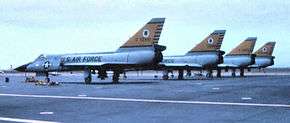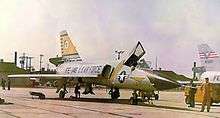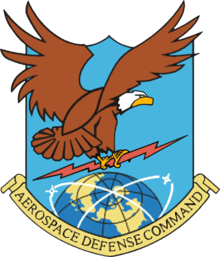456th Fighter-Interceptor Squadron
The 456th Fighter-Interceptor Squadron is an inactive United States Air Force unit. Its last assignment was with the Air Defense Command San Francisco Air Defense Sector stationed at Oxnard AFB, California. It was inactivated on 18 July 1968.
| 456th Fighter-Interceptor Squadron | |
|---|---|
 Three F-106s Castle AFB, about 1966 with the squadron emblem on their tails | |
| Active | 1944–1946; 1954–1955; 1955–1968 |
| Country | United States |
| Branch | United States Air Force |
| Type | Air Defense |
| Insignia | |
| Patch with 456th Fighter-Interceptor Squadron emblem |  |
History
World War II
It was established in late 1944 as a very long range P-47N Thunderbolt fighter squadron. It trained under III Fighter Command. The 456th was deployed to Pacific Theater of Operations (PTO), and assigned to XXI Bomber Command as a long-range escort squadron for B-29 Superfortress bombers engaged in the strategic bombardment of Japan, based on Iwo Jima. After the Japanese capitulation, it was moved to Luzon where the squadron was demobilized; the P-47Ns were returned to storage depots in the United States. It was inactivated as a paper unit in 1946.
Cold War Air Defense


It was reactivated in 1954 under Air Defense Command as an air defense interceptor squadron, and stationed at George AFB, California for the air defense of Southern California. It was equipped with F-86D Sabres. In August 1955 the unit was inactivated, and was reactivated again at Castle AFB in October 1955 with F-86D Sabre Interceptors. In 1957 it began re-equipping with the North American F-86L Sabre, an improved version of the F-86D which incorporated the Semi Automatic Ground Environment, or SAGE computer-controlled direction system for intercepts. The service of the F-86L was brief, since by the time the last F-86L conversion was delivered, the type was already being phased out in favor of supersonic interceptors.
The squadron upgraded in June 1958 into supersonic F-102A Delta Daggers. In September 1959 it received F-106 Delta Darts.
On 22 October 1962, before President John F. Kennedy told Americans that missiles were in place in Cuba, the squadron dispersed one third of its force, equipped with nuclear tipped missiles to Fresno Air Terminal at the start of the Cuban Missile Crisis.[1][2] These planes returned to Castle after the crisis.
The squadron moved to Oxnard AFB on 18 July 1968 and was inactivated the same day, transferring its mission, personnel and equipment to the 437th Fighter-Interceptor Squadron.
Lineage
- Constituted 456th Fighter Squadron on 5 October 1944
- Activated on 15 October 1944
- Inactivated on 25 August 1946
- Redesignated 456th Fighter-Interceptor Squadron on 23 March 1953
- Activated on 8 August 1954
- Inactivated on 18 August 1955
- Activated on 18 October 1955
- Inactivated on 18 July 1968
Assignments
- 414th Fighter Group, 15 October 1944 – 25 August 1946
- 520th Air Defense Group, 8 August 1954 – 18 August 1955
- 28th Air Division, 18 October 1955
- San Francisco Air Defense Sector, 1 July 1960 – 18 July 1968
Stations
- Seymour Johnson Field, North Carolina, 15 October 1944
- Selfridge Field, Michigan, 21 November 1944
- Bluethenthal Field, North Carolina, 19 March – 5 June 1945
- North Field, Iwo Jima, 7 July 1945
- Clark Field, Luzon, Philippines, 23 December 1945
- Floridablanca Airfield, Luzon, Philippines, unknown-25 August 1946
- George AFB, California, 8 August 1954 – 18 August 1955*
- Castle AFB, California, 18 October 1955 – 18 July 1968
- Oxnard AFB, California, 18 July 1968
Aircraft
- P-47 Thunderbolt, 1944–1946
- F-86D Sabre Interceptor, 1954–1955; 1955–1957
- F-86L Sabre Interceptor (SAGE) 1957–1958
- F-102 Delta Dagger 1958–1959
- F-106 Delta Dart, 1959–1968
References
Notes
- McMullen, Richard F. (1964) "The Fighter Interceptor Force 1962–1964" ADC Historical Study No. 27, Air Defense Command, Ent Air Force Base, CO (Confidential, declassified 22 March 2000), pp. 10–12
- NORAD/CONAD Participation in the Cuban Missile Crisis, Historical Reference Paper No. 8, Directorate of Command History Continental Air Defense Command, Ent AFB, CO , 1 Feb 63 (Top Secret NOFORN declassified 9 March 1996). P. 16
Bibliography
![]()
- Cornett, Lloyd H.; Johnson, Mildred W. (1980). A Handbook of Aerospace Defense Organization, 1946–1980 (PDF). Peterson AFB, CO: Office of History, Aerospace Defense Center.
- Maurer, Maurer, ed. (1982) [1969]. Combat Squadrons of the Air Force, World War II (PDF) (reprint ed.). Washington, DC: Office of Air Force History. ISBN 0-405-12194-6. LCCN 70605402. OCLC 72556.
- McMullen, Richard F. (November 1964). The Fighter Interceptor Force 1962 – 1964 (PDF). ADC Historical Study No. 27. Ent Air Force Base, Colorado: Air Defense Command. – Formerly Confidential, declassified 22 March 2000.
- NORAD/CONAD Participation in the Cuban Missile Crisis (PDF). Historical Reference Paper No. 8. Ent Air Force Base, Colorado: Continental Air Defense Command, Directorate of Command History. 1 February 1963. – Formerly Top Secret NOFORN, declassified 9 March 1996.
- "ADCOM's Fighter Interceptor Squadrons". The Interceptor (January 1979) Aerospace Defense Command, (Volume 21, Number 1)
